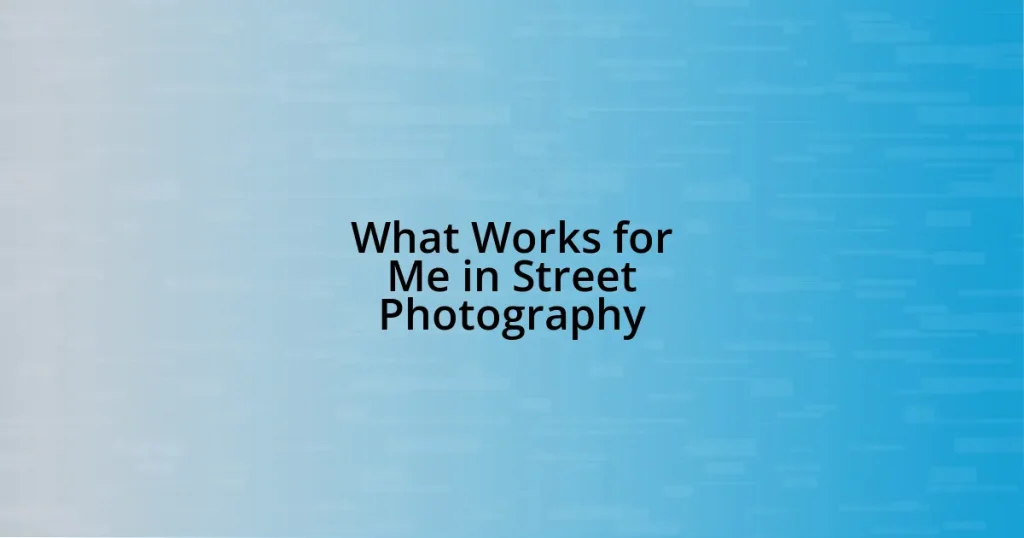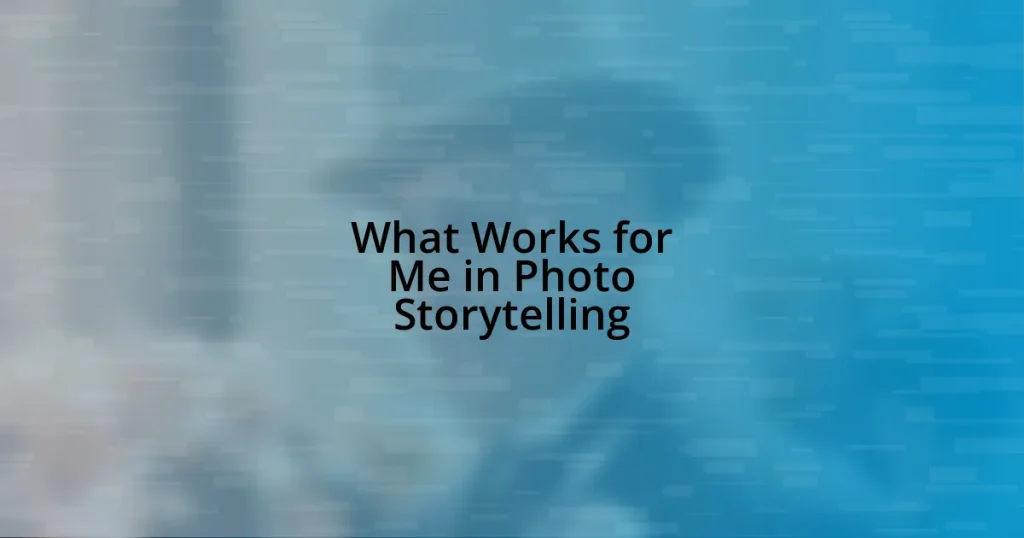Key takeaways:
- Photo essays tell visual stories that convey emotions and perspectives, relying on a strong sequence of images.
- Key elements of a successful photo essay include composition, a clear narrative, and contextual captions that enhance understanding.
- Choosing a compelling theme that resonates personally can create a cohesive and engaging narrative.
- Effective sharing and audience engagement are crucial; utilizing the right platforms and maintaining interaction can amplify the impact of your photo essay.

Understanding Photo Essays
Photo essays are essentially visual stories that capture a theme or narrative through a series of images. I remember the first time I created one; each photograph felt like a piece of a puzzle, contributing to a larger story. Isn’t it fascinating how a single image can evoke myriad emotions?
When I think about the power of a photo essay, I realize that it’s not just about taking pretty pictures. It’s about conveying emotions and perspectives, transforming ordinary moments into something profound. For example, there was a moment when I took candid shots at a local festival; the joy, laughter, and even the fleeting glances between people told stories that words often fail to express.
To truly understand photo essays, one must grasp the importance of sequencing. Each image should build off the last, creating a flow that guides the viewer through the narrative. Have you ever watched a series of photos and felt transported to that moment? That’s the magic of a well-crafted photo essay—it draws you in and invites you to experience, feel, and reflect.

Key Elements of Photo Essays
When I consider the key elements of photo essays, I think about the importance of composition. Every photograph should be thoughtfully framed to emphasize the subject matter. I remember a time when I captured a sunset over a quiet lake. The placement of trees in the foreground created depth, and that image, taken at just the right moment, spoke volumes about tranquility and reflection. Focusing on composition also means being aware of lighting and angles, which can dramatically change the story each image tells.
Another critical element is storytelling. It’s essential to have a clear narrative thread that ties all the images together. For instance, during my adventures in a bustling city, I followed a street performer throughout the day. Each photo portrayed a different dimension of his life, from the joy he brought to others to the quiet moments when he took a break. This personal connection not only made the essay more relatable but also invited the viewer to invest emotionally in the story.
Lastly, captions and context play a pivotal role. Sometimes a simple line can provide clarity or evoke a deeper understanding of the visual narrative. In one of my projects, I included quotes from the people I photographed, which added a layer of authenticity to the images. This technique bridges the gap between the visual and the verbal, enhancing the viewer’s overall experience.
| Element | Description |
|---|---|
| Composition | Thoughtful framing and use of light and angles to enhance the subject. |
| Storytelling | A clear narrative thread that connects the images and evokes emotions. |
| Captions | Contextualizes the visuals, adding clarity and depth to the narrative. |

Choosing a Compelling Theme
Choosing a compelling theme can make or break a photo essay. I remember working on a photo essay about winter in my community, capturing everything from the frost-covered trees to children playing in the snow. Each photograph sparked a memory, a feeling that connected me to the season in a deeply personal way. When you select a theme that resonates with you, it’s incredible how effortlessly the images flow together, forming a cohesive narrative.
Here are some aspects to consider when choosing your theme:
- Personal Connection: Choose something that speaks to your experiences or emotions; it makes your narrative more authentic.
- Simplicity: A clear, focused theme helps in framing your story without overwhelming the viewer.
- Relevance: Think about themes that might resonate with your audience; shared experiences foster deeper connections.
- Visual Potential: Consider whether the theme lends itself to strong imagery; interesting visuals can elevate your narrative.
- Cultural Context: Themes rooted in cultural or social significance can offer layers of meaning and enrich your essay.
When the theme feels right, everything else just falls into place. I vividly recall how easy it was to photograph that winter essay once I identified the heart of my theme. Each click of the shutter felt like capturing a piece of my own nostalgia and inviting others to share in that warmth.

Capturing Impactful Images
Capturing impactful images requires a keen awareness of the emotions they evoke. I recall a day spent at a local farmers’ market, camera in hand. As I moved through the stalls, I paused to photograph a vendor’s weathered hands gently arranging vibrant produce. It struck me how much character those hands revealed — a lifetime of hard work and pride. That single image, with its intricate details and genuine expressions, conveyed not just a market scene but an entire story about the dedication behind small-scale farming.
Another aspect I find crucial is the ability to embrace spontaneity. One afternoon while hiking, I stumbled upon a group of children playing in a rain-soaked field. Their uninhibited laughter and gestures were incredible to witness. I instinctively raised my camera and captured the moment without overthinking it. Later, when reviewing those shots, I realized how their raw joy instantly drew me back to that carefree moment. I think it’s fascinating how the best images often come when you’re not trying too hard — they just happen as you connect with your surroundings.
Sometimes, the strongest images come from discomfort. I remember photographing a protest, the air thick with emotion and tension. I was initially hesitant to click the shutter; after all, the scenes unfolding were powerful and heavy. However, once I began capturing the expressions of determination and solidarity in the crowd, I felt a profound responsibility to document their fight for justice. Those images not only represented the event but also resonated deeply with my own values and beliefs. Isn’t it interesting how our discomfort can push us to create something that resonates on a much broader level?

Crafting a Narrative Flow
Crafting a narrative flow in a photo essay is much like weaving a tapestry, where each image contributes to a larger story. I remember working on a project centered around community gardens. At first, I scattered my shots across different plots, but then I realized that following the journey from seed to harvest created a more engaging narrative. By connecting the images in this way, I not only showcased the growth process but also invited viewers to share in the anticipation and joy of seeing those once tiny seeds flourish into vibrant vegetables.
Another key element in creating that flow is the sequence of your images. I learned this while compiling a photo essay on local artisans. Initially, I arranged the photos randomly, and it felt disjointed. But when I shifted my images to reflect the steps in the crafting process — from raw materials to the final product — it felt like a cohesive journey. It’s fascinating to think how ordering images thoughtfully can guide the viewer’s emotions, almost like telling them a story with a beginning, middle, and end. Have you ever noticed how certain sequences just feel right? They naturally draw you in.
Finally, I believe that captions play a pivotal role in enhancing the narrative flow. I once created an essay featuring street musicians, and as I captured their performances, I also wrote brief anecdotes about their backgrounds. Those little snippets transformed the visual experience, offering glimpses into their lives and motivations. It made me wonder — how much of your own story can you share through those tiny explanations? I found that when you sprinkle in a bit of context or emotion, it not only frames the images but also deepens the connection between the viewer and the subjects. This interaction can truly elevate your photo essay into something memorable.

Editing Your Photo Essay
Editing is where the magic often resumes in a photo essay. I remember sifting through hundreds of images after a weekend trip to a wildlife reserve. Initially overwhelmed, I learned to be selective, which transformed my approach. Instead of including every shot, I focused on a few that conveyed the essence of the experience — like a lone elephant silhouetted against a sunset, its majesty summarizing the adventure with powerful clarity. Have you ever felt how a single picture can echo an entire journey?
During the editing process, I also found that grouping similar themes can create an emotional resonance. I worked on a project highlighting urban life, and when I arranged images of bustling street vendors alongside serene park-goers, an unexpected harmony emerged. It was striking to see how these contrasting scenes spoke to the rhythm of city life — moments of chaos mingling with tranquility. How often do we overlook the beauty in contrasting elements that can enrich our narratives?
Moreover, I’ve learned that technical adjustments can elevate the storytelling aspect of a photo essay. While editing one of my first essays, I played with cropping and brightness to enhance an image of a child splashing in puddles. By centering the child and brightening the colors, the photograph became vibrant and lively, pulling viewers right into the playfulness of childhood. How can such small tweaks transform our perception of an image? It’s a reminder of the power we hold in the editing room to refine and reshape our stories.

Sharing Your Photo Essay Effectively
When it comes to sharing your photo essay effectively, the platform you choose can significantly impact how your story is received. I recall a time when I uploaded a photo essay to a gallery website, only to see it buried under countless other submissions. In hindsight, leveraging social media proved much more effective. With my community sharing the post, the engagement skyrocketed. Have you ever experienced how an image can travel from just one person to thousands with the right digital push? It’s fascinating to see how the medium can amplify your voice.
Another aspect that consistently resonates with my audiences is storytelling through captions. There was an instance when I held an exhibition for my travel photo essay. I included handwritten notes beside each photograph, sharing my thoughts and experiences in the moment. Those little anecdotes created a personal connection, allowing viewers to see the world through my eyes. It made me think—what story are you telling through your images, and how can you deepen that connection with your audience?
Lastly, it’s vital to maintain engagement after you share your essay. I learned this the hard way when I posted my work and didn’t interact with viewers. A simple comment or responding to questions can elicit more conversations and foster a sense of community around your work. It’s intriguing to realize that engagement is a two-way street. How can we, as creators, open up that dialogue? Building a rapport with your audience not only enhances the impact of your photo essay but also enriches your future projects with valuable feedback and inspiration.
















